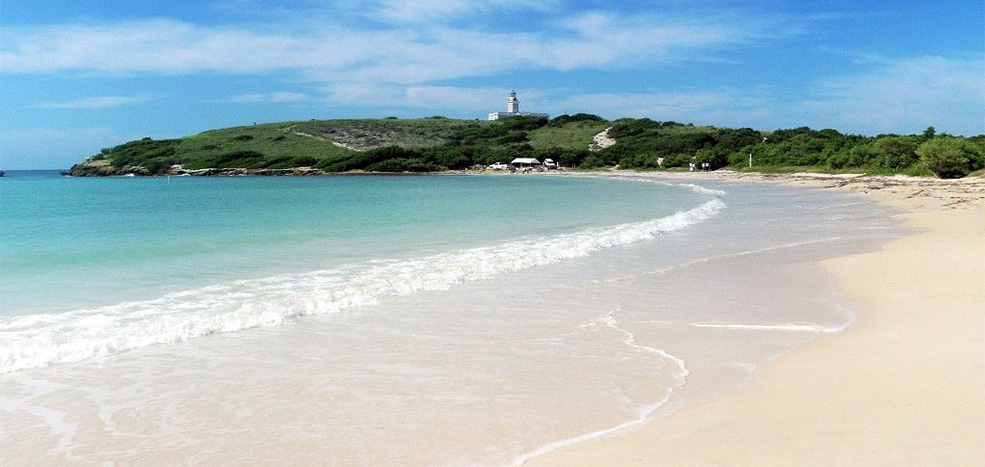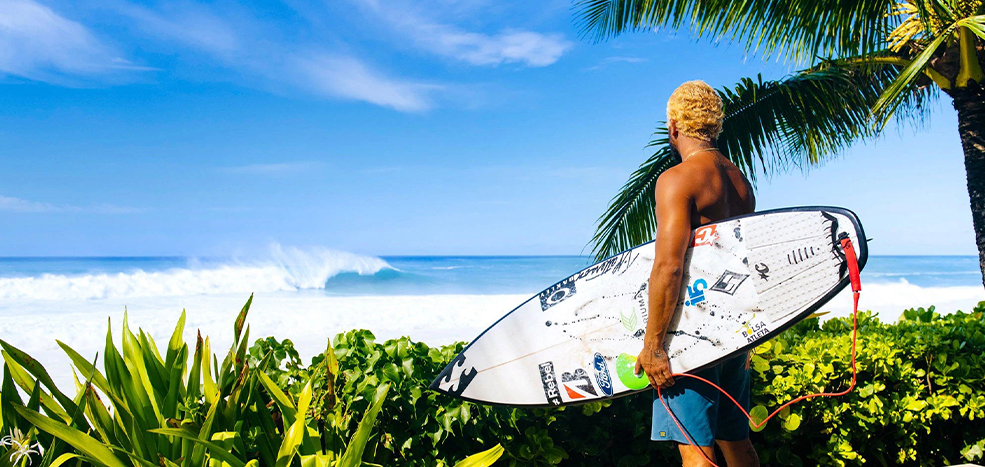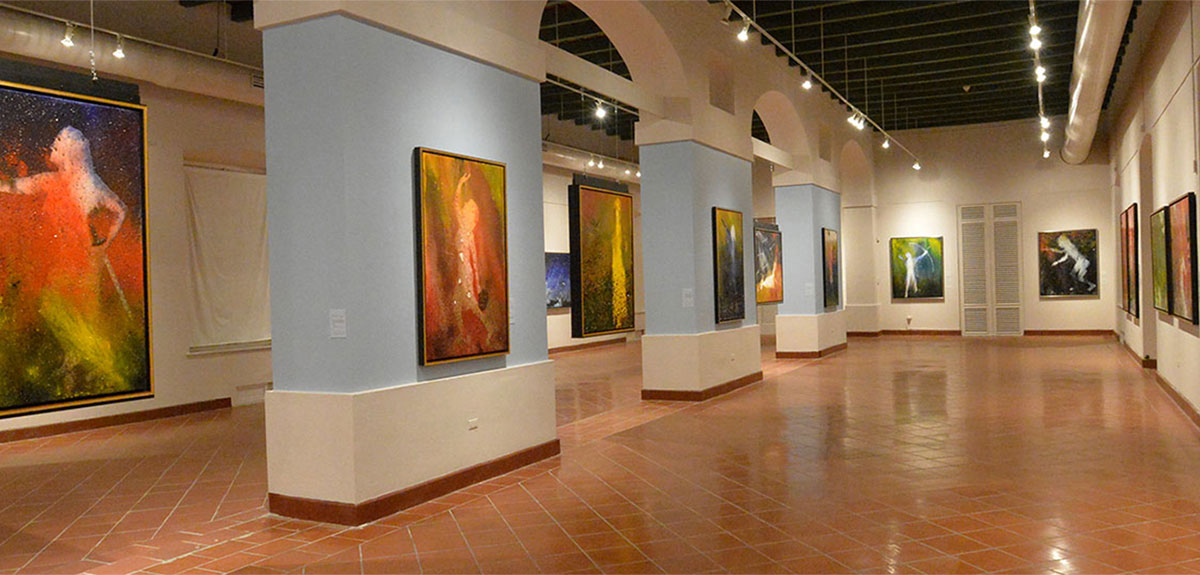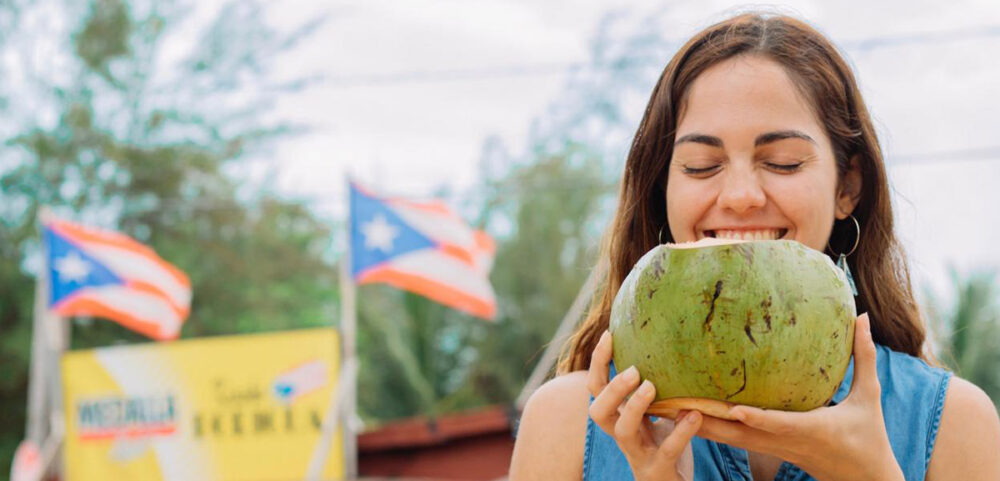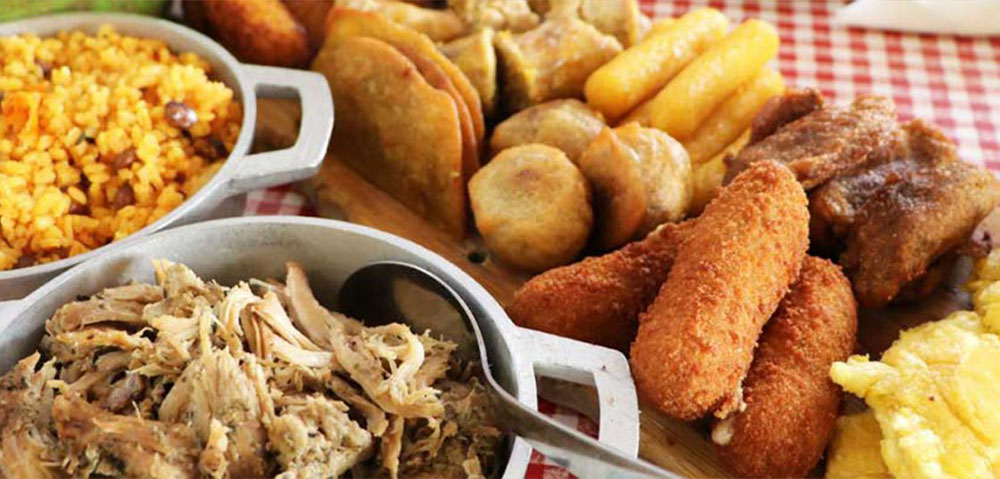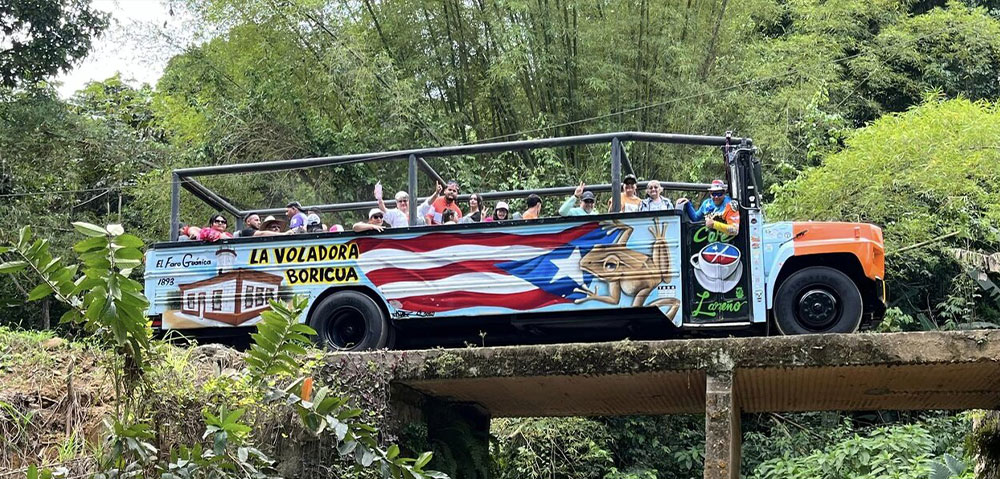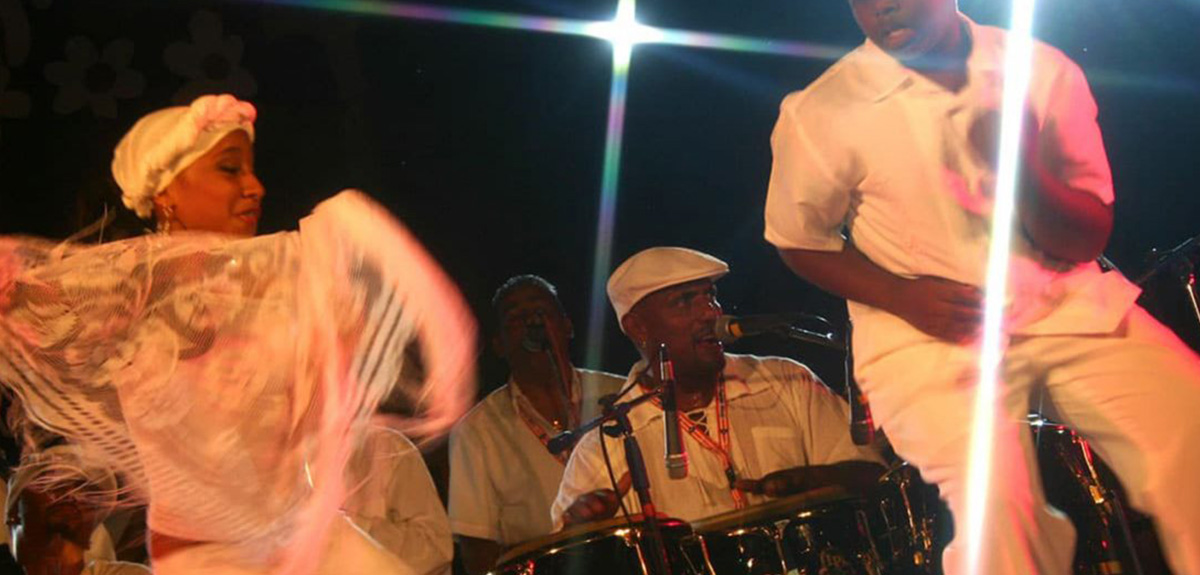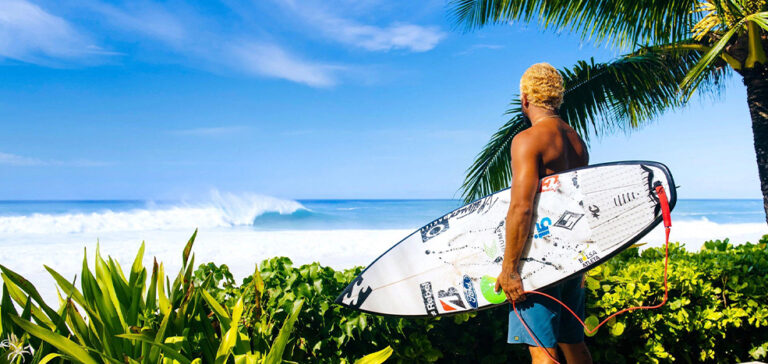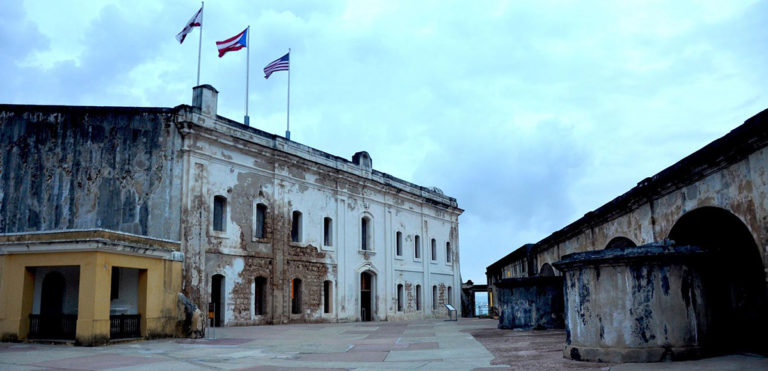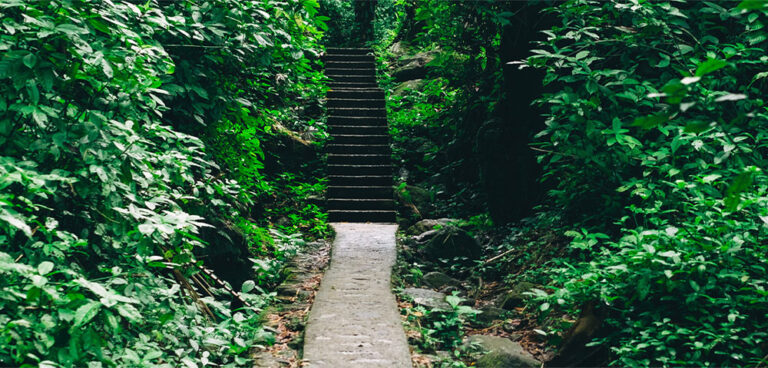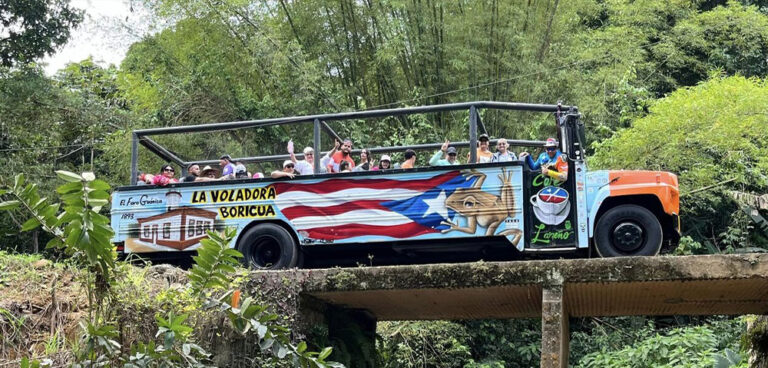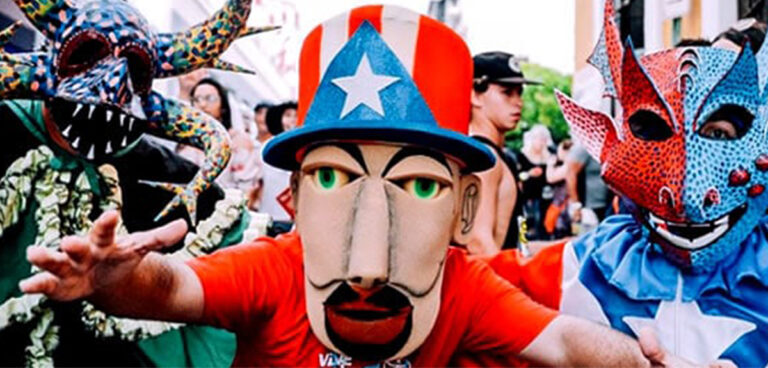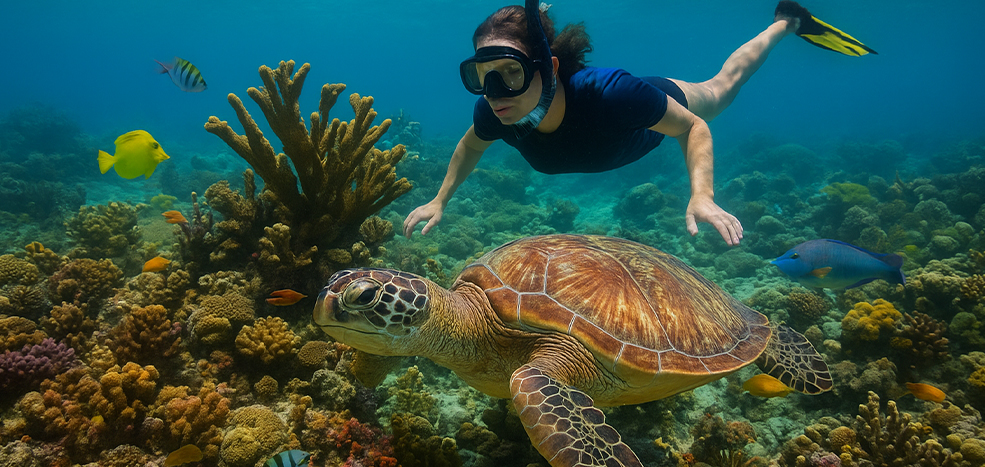
Best Snorkeling and Diving Spots in Puerto Rico
Explore the Reefs, Shipwrecks, and Marine Biodiversity of this Caribbean Paradise
Puerto Rico is an underwater paradise in the Caribbean, with warm, crystal-clear waters offering visibility of up to 40 meters (130 feet) for much of the year. Its coral reefs, gorgonian gardens, and historic shipwrecks create a perfect environment for snorkelers and divers of all skill levels.
With over 700 kilometers of coastline and several protected marine reserves, such as La Cordillera, Tres Palmas, and La Parguera, the island is home to rich marine biodiversity. It is common to encounter sea turtles, rays, tropical fish, dolphins, and, seasonally, humpback whales along the west coast.
Local operators certified by PADI and SSI promote safe and sustainable marine tourism, supporting coral conservation through eco-friendly sunscreen use and environmental education.
From coral gardens to historic shipwrecks, every dive in Puerto Rico reveals a vibrant world full of color and life—an experience that combines adventure, nature, and conservation.
The Mona Passage and Its Uninhabited Islands
Off the west coast of Puerto Rico lie Desecheo, Mona, and Monito, three uninhabited islands that are part of the Mona Passage, renowned for their unique biodiversity and nicknamed “the Galápagos of the Caribbean.” This area is a true marine and terrestrial sanctuary, where scientists and divers encounter endemic species and nearly pristine ecosystems.
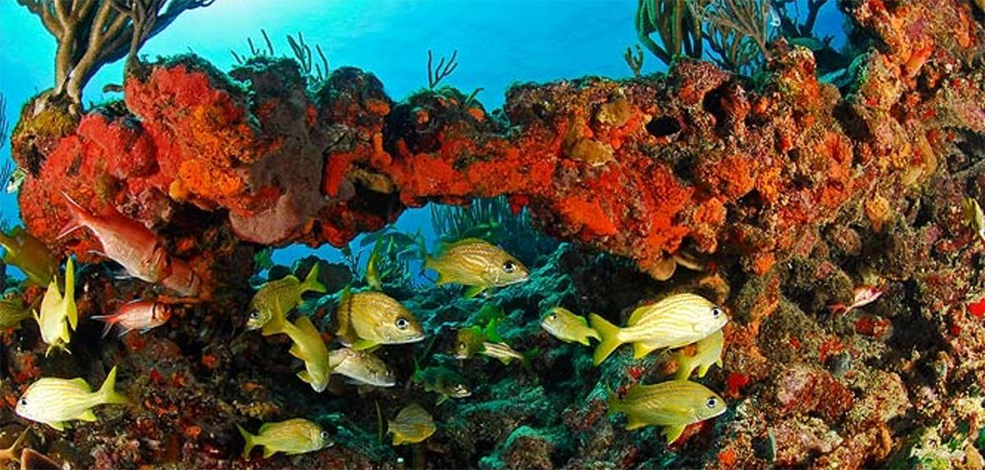
The Mona Passage
The clear waters of the passage, with visibility exceeding 30 meters (100 feet), allow exploration of colorful reefs, underwater canyons, caves, and rock formations. Gorgonians (sea fans), hawksbill and green turtles, lobsters, starfish, and large schools of tropical fish inhabit these waters. Dolphins, reef sharks, and manta rays can also be spotted, especially in deeper areas or during seasonal migrations.
Mona Island, designated a Natural Reserve by the Department of Natural and Environmental Resources (DRNA), protects marine and terrestrial ecosystems not found anywhere else in the Caribbean. Its underwater canyons and caves are ideal for experienced divers, while shallow, protected areas offer exceptional snorkeling experiences suitable for beginners. Elkhorn and brain coral reefs stand out for their diversity and ecological health.
Access to Mona, Monito, and Desecheo is only possible via authorized boats from Mayagüez, Aguadilla, or Cabo Rojo. Excursions should be planned in advance and conducted with certified operators who follow responsible tourism practices, respect marine habitats, and educate visitors about the conservation of protected species. Visiting these islands combines adventure, ecotourism, and environmental learning, offering a unique experience for those seeking to discover Puerto Rico’s underwater treasures.
Culebra Beaches
The beaches of Culebra are recognized as some of the best spots for snorkeling and diving in Puerto Rico. This small island, located about 17 miles east of the main island, is known for its crystal-clear waters, well-preserved coral reefs, and abundant marine life, making it an ideal destination for both beginners and experienced divers.
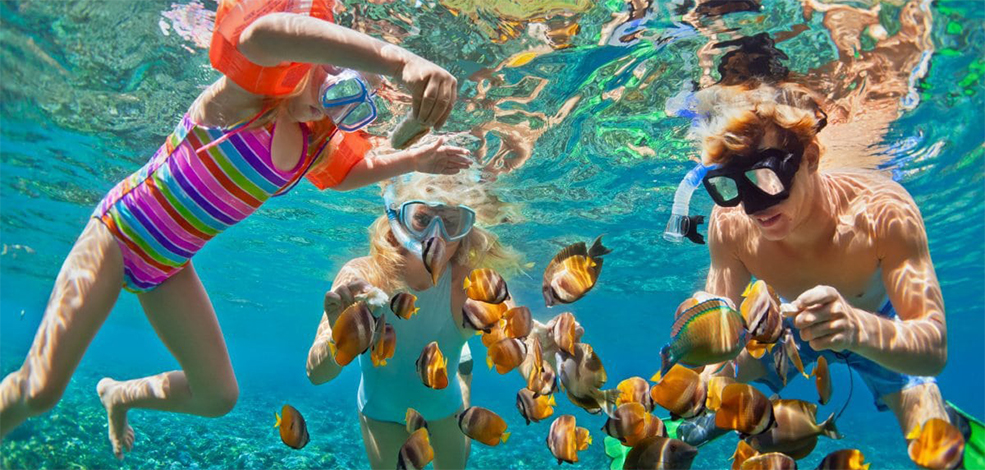
Culebra Beaches
Among the top snorkeling beaches are Carlos Rosario, Playa Tamarindo, Playa Melones, Punta Soldado, and the iconic Playa Flamenco, as well as nearby small islets like Culebrita, which offer unique and less crowded underwater experiences.
At Playa Flamenco, the best snorkeling spot is at the eastern end, in an area known as “Shark Cages” or “El Muellecito.” Here, visitors can observe parrotfish, eels, sea turtles, colorful corals, and schools of tropical fish moving among the rock formations.
For those looking to explore beyond the beaches, boat excursions allow access to remote, peaceful areas perfect for swimming or diving. Culebra is accessible by ferry from Ceiba, with trips lasting approximately 45 minutes, or by small plane from San Juan, Ceiba, or Vieques. Visitors can bring their own snorkeling gear or rent it in Dewey, the main town on the island, which also offers restaurants, shops, and tourist services.
Culebra, along with Vieques and Mona, is part of the Puerto Rican Archipelago National Wildlife Refuge, a protected area that safeguards critical marine species and ecosystems. Responsible tourism is essential: do not touch corals, do not feed marine life, and take all trash with you. Following these guidelines ensures the conservation of this underwater paradise for future generations.
Escambrón Beach – San Juan
Escambrón Beach, located next to the Caribe Hilton Hotel in Puerta de Tierra, is one of the most popular urban snorkeling and diving spots in San Juan. Its natural rock formations protect the shore from the strong Atlantic waves, creating a calm bay ideal for swimming and exploring the underwater world.
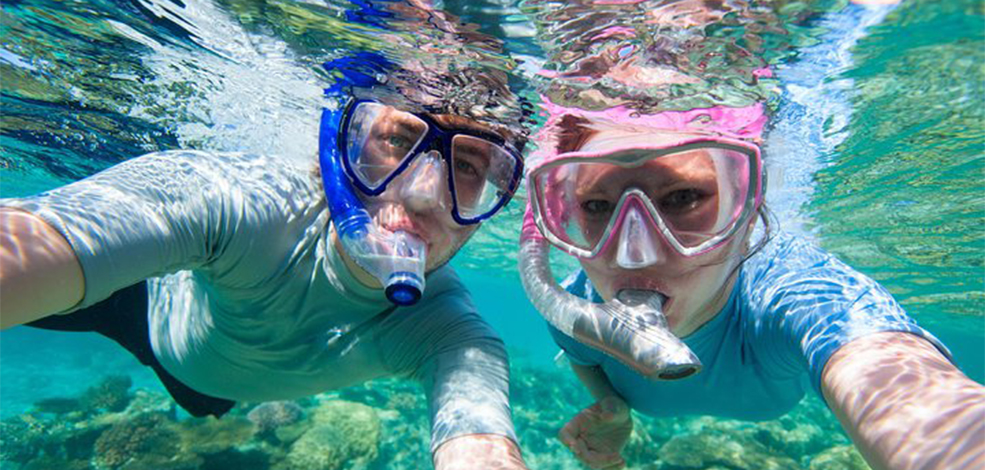
Escambrón Beach – San Juan
The constant presence of divers and snorkelers has made the local fish accustomed to people, allowing safe close encounters and making it perfect for beginners and families.
On the seafloor, visitors can see the collapsed structure of an old bridge, now serving as an artificial reef providing shelter for tropical fish, sea urchins, shrimp, and occasionally sea turtles. Additionally, the Escambrón Marine Park features underwater statues, sunken structures, and restored coral gardens. Lucky visitors may also spot rays and manatees visiting the bay.
Although the biodiversity is not as extensive as in Culebra or Vieques, Escambrón stands out as the best snorkeling option within the metropolitan area. Its easy access, nearby parking, and amenities make it a convenient and safe choice, and its Blue Flag certification ensures clean waters and optimal swimming conditions.
Escambrón is ideal for those wanting to enjoy the Caribbean Sea without leaving San Juan, combining a day at the beach with history and culture, as it is very close to Old San Juan and Luis Muñoz Rivera Park.
Rincón – Snorkeling and Diving
Known worldwide for its winter waves, Rincón transforms in the summer into a true paradise for snorkeling and diving, when the waters calm and visibility exceeds 60 feet. The reefs that make the west coast famous become underwater gardens teeming with marine life, from parrotfish and rays to sea turtles and schools of tropical fish.

Rincón – Snorkeling and Diving
Steps Beach, located within the Tres Palmas Marine Reserve, is the most popular snorkeling spot in the area. This elkhorn coral reef, one of the largest and healthiest in the Caribbean, is protected by the reserve, ensuring a calm and safe experience without nearby boats. Local dive schools offer guided tours that combine adventure with marine conservation education.
Rincón also serves as a gateway to the uninhabited islands of Desecheo and Mona, known for their pristine reefs and exceptional biodiversity. These boat expeditions allow advanced divers to explore underwater caves, canyons, and unique pelagic species.
Whether surfing in winter or diving in summer, Rincón offers the best of both worlds, making it a must-visit destination for sea lovers, adventure seekers, and nature enthusiasts.
La Parguera Natural Reserve – Lajas
Located on the southwest coast of Puerto Rico, La Parguera Natural Reserve is a top destination for snorkeling, diving, and kayaking. This protected ecosystem combines coral reefs, small cays, mangroves, and natural channels, home to sea turtles, dolphins, groupers, barracudas, and a wide variety of tropical fish.
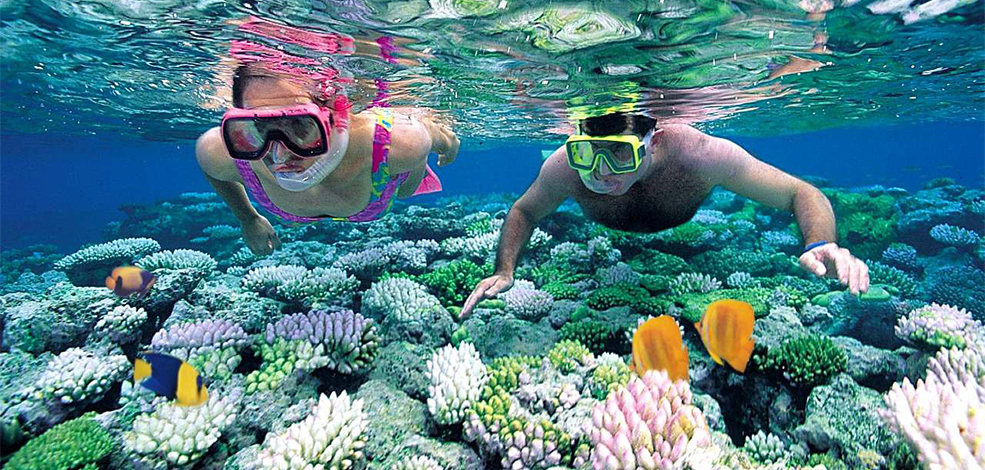
La Parguera Natural Reserve – Lajas
One of its main attractions is the Bioluminescent Bay of La Parguera, the only bay in Puerto Rico where swimming is allowed. Visitors can experience the magical glow of the water as it lights up with every movement at night.
The best snorkeling spots are around nearby cays such as Cayo Enrique, Mata La Gata, and Cayo Caracoles, accessible via guided tours from the town of La Parguera. Its shallow waters and excellent visibility make it perfect for beginners, while coral reefs and seagrass beds offer a vibrant ecosystem for advanced divers.
Many tours combine daytime snorkeling with a night visit to the bioluminescent bay, allowing guests to enjoy two unforgettable experiences in one day. With its relaxed atmosphere, waterfront restaurants, and breathtaking scenery, La Parguera is a natural paradise that blends adventure, ecotourism, and Caribbean beauty.
Tamarindo and Carlos Rosario Beaches – Culebra
With rolling hills as a backdrop and crystal-clear waters inviting exploration, Tamarindo and Carlos Rosario Beaches are two of the most spectacular snorkeling and diving spots in Culebra, east of Puerto Rico. Both are part of the Luis Peña Nature Reserve, a protected area that preserves coral reefs, mangroves, and an impressive diversity of marine life.

Tamarindo and Carlos Rosario Beaches – Culebra
Playa Tamarindo is easily accessible by vehicle and allows snorkeling directly from the shore, making it ideal for beginners and families. Visitors can encounter hawksbill and green sea turtles, parrotfish, giant groupers, rays, and colorful corals. The water’s clarity provides exceptional visibility, perfect for underwater photography.
Playa Carlos Rosario, on the other hand, is a true hidden paradise. Accessible only by foot from Playa Flamenco or by boat, it remains quiet and less crowded. Its extensive and well-preserved coral reef hosts hundreds of tropical fish, sponges, and sea fans, making it a favorite spot for certified divers seeking more advanced experiences.
Local operators offer guided tours that cover over 50 snorkeling and diving points around Culebra, including these beaches, while promoting responsible tourism and environmental education.
At just seven miles long and two miles wide, Culebra retains its natural, relaxed charm. The island features small hotels, inns, and beachfront cottages, perfect for enjoying the Caribbean paradise at a leisurely pace and connecting with nature.
Tres Palmas Marine Reserve – Rincón
On the northwest coast of Puerto Rico, along the Atlantic Ocean, lies Tres Palmas Marine Reserve, one of the island’s most treasured natural sites. Renowned for its stunning reefs and rich biodiversity, Tres Palmas attracts surfers during the winter, with waves that can exceed 30 feet, and transforms into a snorkeling and diving paradise in the summer when the waters calm and become crystal-clear.

Tres Palmas Marine Reserve – Rincón
The reserve protects seven endangered coral species, including the rare and healthy elkhorn coral. Its reefs are home to angelfish, groupers, moray eels, spiny lobsters, sea turtles, and occasionally dolphins and migrating whales.
Tres Palmas encompasses three main beaches: Steps Beach, Dogman’s Beach, and Little Malibu Beach. Steps Beach is the most famous, featuring dense elkhorn coral reefs that provide food and shelter for a wide variety of marine life.
With its clear waters and protected ecosystem, Tres Palmas is ideal for beginner snorkelers as well as experienced divers. Local dive centers and environmental organizations offer guided tours and educational programs focused on marine conservation and responsible tourism.
Beyond the underwater world, Rincón offers a relaxed atmosphere with stunning sunsets, local cafés, and an authentic coastal community vibe, making a visit to Tres Palmas an experience that blends adventure, nature, and the true essence of Puerto Rico.
Gilligan’s Island – Guánica
With shallow, crystal-clear waters, healthy reefs, and low weekday crowds, Gilligan’s Island has become one of Puerto Rico’s most family-friendly snorkeling destinations. Its gentle currents and colorful schools of tropical fish create a safe and enjoyable environment for beginners and young snorkelers.
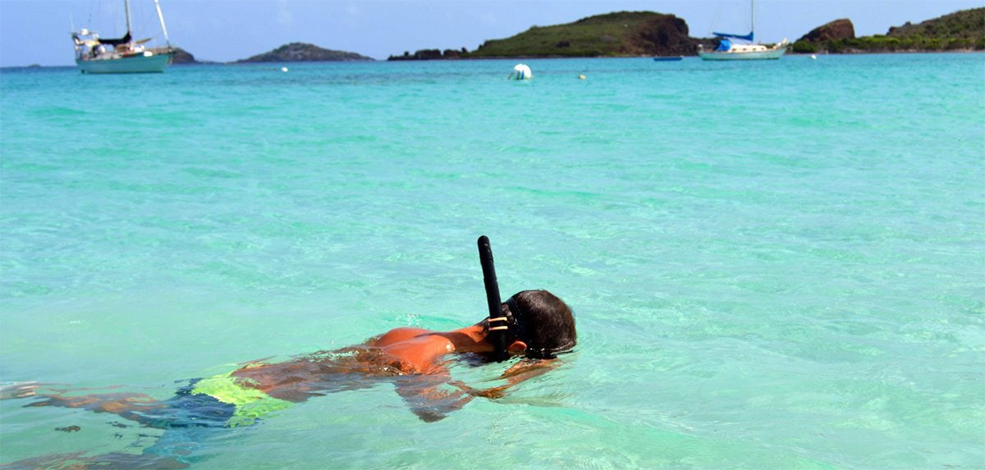
Gilligan’s Island – Guánica
The island’s underwater ecosystem includes well-preserved corals, angelfish, snappers, damselfish, and occasional rays, making every snorkeling adventure both exciting and educational. Gilligan’s Island is part of the Cayos de Caña Gorda, a cluster of small islets easily explored by kayak or boat, offering multiple adventure routes close to the coast.
Families can rent kayaks from the Guánica marina to explore the islets or paddle through the calm nearby mangrove channels. With no strong currents, it is safe to swim around the entire island, making it an ideal spot for children and beginner snorkelers.
Access to Gilligan’s is easy—a short 10-minute ferry ride from Guánica or a roughly 30-minute kayak trip from the coast. Beyond its waters and marine life, the area offers tranquil beaches, soft sands, and protected natural landscapes, perfect for a day of relaxation and family fun in an unparalleled natural setting.
Vieques – Snorkeling and Diving
The biodiversity of Vieques, its crystal-clear waters, and its military history make this island a fascinating destination for snorkeling and diving in Puerto Rico. Located off the east coast of the main island, Vieques is home to the Vieques National Wildlife Refuge, which protects the thriving marine life and coral reefs in the area. This protection ensures some of the most attractive and family-friendly snorkeling experiences, with frequent encounters with green turtles, spotted rays, and colorful tropical fish.
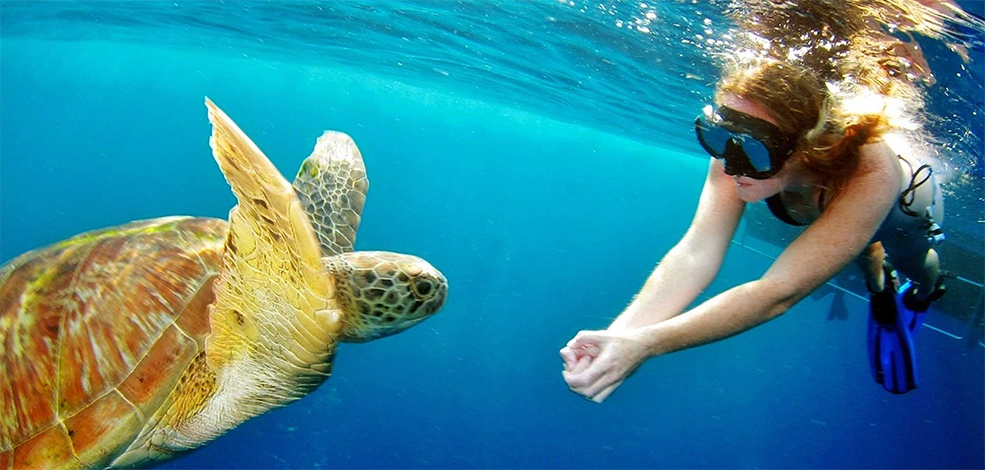
Vieques – Snorkeling and Diving
For decades, Vieques was occupied by the U.S. Navy, keeping much of the island uninhabited and shielding its reefs from human impact. This isolation allowed corals and marine life to flourish naturally, making Vieques one of the most pristine snorkeling and diving destinations in the Caribbean.
Today, Vieques offers vibrant marine ecosystems combined with historical elements, providing unique underwater experiences. Snorkelers and divers may encounter green turtles, hawksbill turtles, spotted rays, nurse sharks, and schools of tropical fish. Additionally, structures and artifacts left by the Navy have become artificial reefs teeming with life, offering exceptional opportunities for underwater photography.
Top snorkeling and diving spots in Vieques include:
- La Chiva (Blue Beach): Crystal-clear waters with seagrass beds teeming with fish.
- Punta Arenas: A sense of isolation with panoramic views and calm waters perfect for swimming.
- Mosquito Pier: Recommended for experienced swimmers and divers due to abundant marine life.
- Rompeolas-Mosquito (north coast): An old military pier built in 1941 and abandoned in 1943. Today, coral-covered pillars and beams create a vibrant habitat for turtles, starfish, sea urchins, and colorful tropical fish.
Vieques offers a unique combination of history, conservation, and marine biodiversity, making it a must-visit destination for unforgettable snorkeling and diving adventures in Puerto Rico.
Isla Caja de Muertos – Coffin Island
For those staying near Ponce, the impressive Isla Caja de Muertos is a must-visit destination for snorkeling enthusiasts. Located approximately 8 miles (13 km) off the coast, the island earned its name from an 18th-century French author who noted that its shape resembled a corpse in a coffin. Since then, the island has also been associated with pirate legends, adding a historical and mysterious charm to any visit.
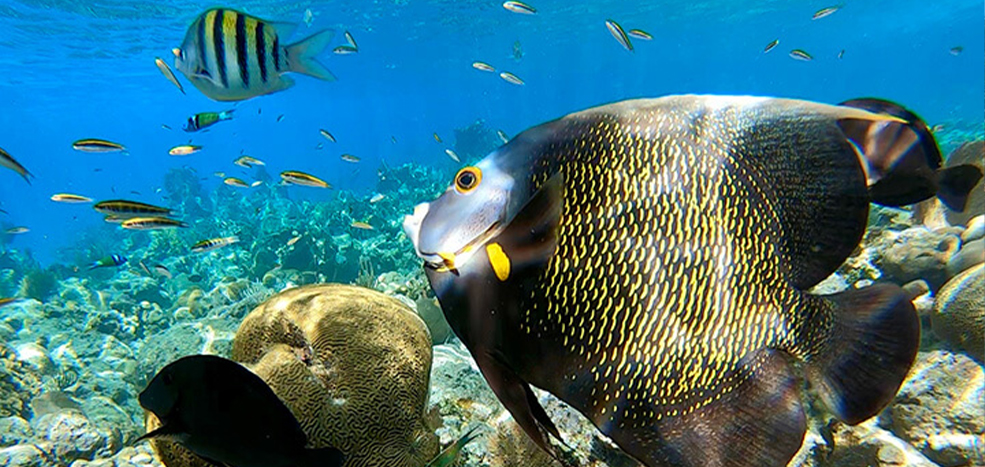
Isla Caja de Muertos – Coffin Island
Snorkeling at Isla Caja de Muertos
To get there, visitors need to book a full-day tour with local operators or take the ferry from La Guancha Boardwalk in Ponce. Declared a natural reserve, the island features hiking trails, stunning beaches, a cave, and a 19th-century historic lighthouse. Pelícano Beach stands out as a Blue Flag Beach, recognized for its cleanliness, water quality, and safety for visitors.
The best snorkeling is in the northeast area of the island, where well-preserved coral reefs allow swimmers to encounter protected sea turtles, colorful tropical fish, sea urchins, lobsters, and diverse coral species. Tour operators typically provide snorkeling equipment, but bringing your own ensures the best experience in these clear, high-visibility waters.
Beyond being an excellent destination for beginners, Caja de Muertos’ reefs and rock formations also offer engaging challenges for advanced snorkelers, combining marine biodiversity with spectacular underwater landscapes. With its unique mix of history, nature, and marine life, the island has become one of the most attractive underwater treasures along Puerto Rico’s southern coast.
La Cordillera Natural Reserve – Fajardo
There is no place more pristine than La Cordillera in Fajardo. This group of nine small cays, including Icacos, Cayo Lobos, Palomino, Cayo Ratones, and others, stretches nearly 20 nautical miles. Most of the cays are accessible by water taxi, catamaran, or private charter, allowing visitors to spend the day exploring lush seagrass meadows and untouched beaches.
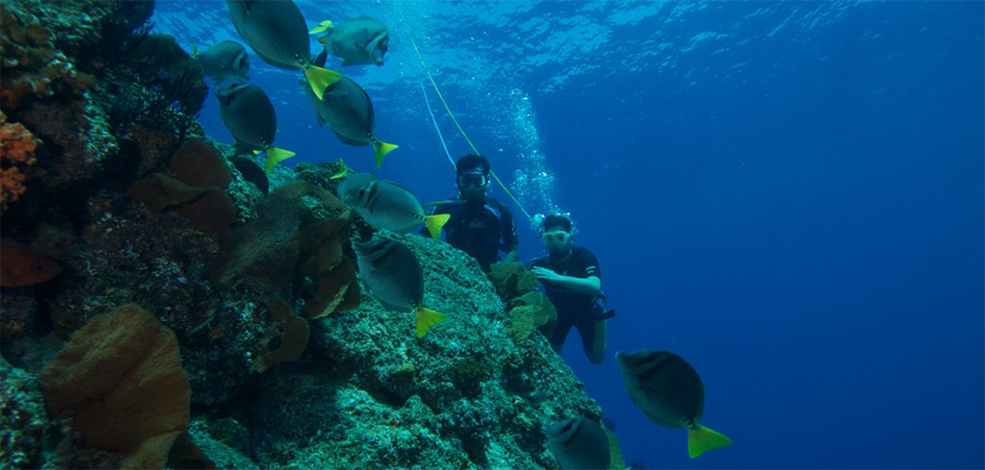
La Cordillera Natural Reserve – Fajardo
Snorkeling and Diving at La Cordillera
In this vibrant marine ecosystem, snorkelers and divers can encounter green turtles, manatees, sea cucumbers, starfish, juvenile tropical fish, queen conchs, moray eels, and rays. The reefs feature rocky formations, fire coral, and elkhorn coral—a protected, endangered species. With water visibility often exceeding 30 meters (100 feet) and abundant marine life, La Cordillera is a must-visit destination for snorkeling and diving in Puerto Rico.
The area is also a critical site for the conservation of marine species and migratory birds. Many guided tours include insights on local wildlife and environmental protection efforts. Shallow waters around some cays are perfect for beginners, while deeper areas allow experienced divers to explore underwater caves and well-preserved coral gardens.
With its pristine beaches, crystal-clear waters, and rich marine biodiversity, La Cordillera offers a combination of adventure, ecotourism, and protected nature, making it an exceptional snorkeling and diving destination on Puerto Rico’s east coast.
Explore, Enjoy, and Protect Puerto Rico’s Marine Treasures
Puerto Rico is a true underwater paradise. From the beaches of Culebra and Vieques to protected reserves like La Parguera, Tres Palmas, and La Cordillera, every dive reveals a world full of corals, tropical fish, turtles, and unique marine life.
Enjoy the sea responsibly: do not touch the corals, do not feed the animals, and take your trash with you. This helps keep these ecosystems healthy so everyone can continue exploring.
Whether you are seeking relaxing snorkeling, advanced diving, or simply a day in nature, Puerto Rico offers unforgettable experiences that combine fun and conservation. Dive in, discover, and respect why our island is one of the Caribbean’s most special snorkeling and diving destinations.
Mejores Lugares para Kayak y Paddleboard en Puerto Rico
Puerto Rico es un verdadero paraíso para los amantes del agua. Gracias a su clima cálido durante todo el año, aguas cristalinas y abundante vida marina, la isla ofrece el escenario perfecto para un día —o una aventura nocturna— de kayak o paddleboarding.
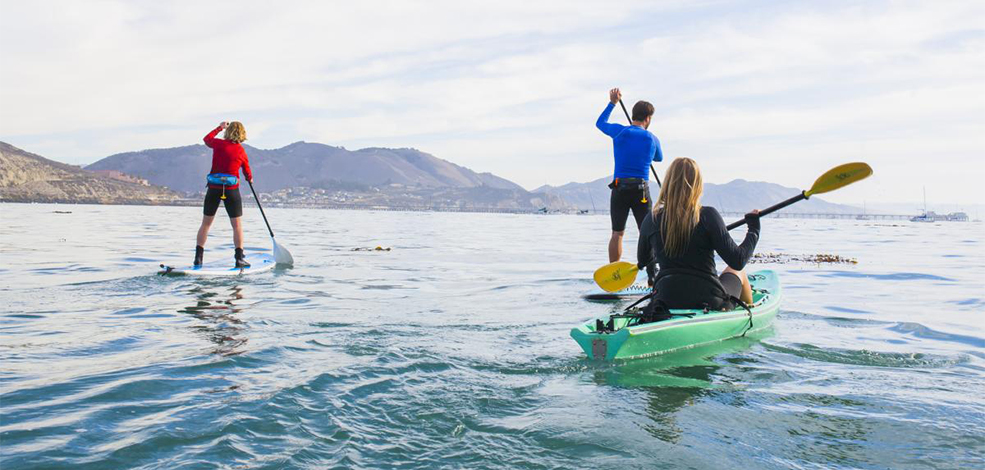
Mejores Lugares para Kayak y Paddleboard en Puerto Rico
Con una selección casi interminable de playas vírgenes, excursiones guiadas y numerosos lugares para alquilar equipos, puedes disfrutar de experiencias inolvidables en el agua. Las corrientes suaves, conocidas como “clase cero”, hacen que muchas áreas sean aptas para principiantes y familias con niños.
En la Ciudad – San Juan
Las oportunidades para kayak y paddleboard en la capital se concentran principalmente en los barrios de Condado e Isla Verde. Un lugar popular es la Laguna del Condado, donde puedes remar en un ambiente tranquilo y observar peces, tortugas e incluso manatíes. Los alquileres de kayaks y tablas de paddle están disponibles en la zona, incluyendo opciones de paddleboard con fondo de cristal para ver la vida marina mientras remas.

Reserva Natural La Cordillera – Fajardo
Si buscas un ambiente más relajado, a solo 20 minutos al este, Piñones ofrece la Laguna Torrecilla, rodeada de manglares y pequeñas islas para explorar. Por su parte, Isla Verde, cerca del Fairmont El San Juan Hotel, es ideal para mejorar tus habilidades en aguas tranquilas, con varias opciones de alquiler de equipos.
Consejos para Disfrutar las Playas de Puerto Rico
Disfrutar de las playas de Puerto Rico va más allá de tomar el sol. Cada rincón costero tiene sus propias reglas y características que conviene conocer para protegerte, disfrutar al máximo y cuidar del entorno natural.
- Llegue temprano y disfrute con calma:
Evite las multitudes y aproveche las horas más frescas del día. Llegar antes del mediodía le permitirá encontrar estacionamiento y disfrutar de aguas más tranquilas, especialmente en playas populares como Flamenco, Combate o Crash Boat. - Opte por protector solar ecológico:
Proteja su piel y el ecosistema marino. Busque protectores “reef-safe” (libres de oxibenzona y octinoxato) para evitar dañar los corales y la vida marina. Con pequeñas acciones se contribuye a la conservación de las playas. - Respete la vida marina:
Observe, pero no toque. Las tortugas, peces y estrellas de mar forman parte del delicado equilibrio del ecosistema. En playas como Culebra, Caja de Muertos y Vieques, encontrará zonas de anidación de tortugas marinas. Evite luces fuertes o ruidos durante la noche para no alterar su hábitat. - Recoja su basura y deje la playa limpia:Lleve bolsas reutilizables y evite plásticos desechables. Al finalizar su visita, asegúrese de dejar el área más limpia de como la encontró. Así ayuda a mantener las playas hermosas para todos y a proteger la fauna marina.
- Busque información sobre las corrientes:Antes de nadar, observe las banderas de advertencia y siga las recomendaciones de los salvavidas. En playas como Jobos, Domes o Montones, las corrientes pueden ser fuertes. Si no está seguro, permanezca cerca de la orilla.
- Prepárese según el tipo de playa:
- Playas naturales o cayos (como Icacos o Gilligan’s Island): no cuentan con servicios, por lo que lleve agua, sombrilla y refrigerios.
- Balnearios oficiales (como Luquillo o Seven Seas): ofrecen duchas, baños, estacionamiento y vigilancia.
- Sea respetuoso con la cultura local:Las playas son lugares de convivencia familiar. Mantenga la música a un volumen moderado y respete las normas del área. Si organiza un picnic o participa en el “chinchorreo”, sea considerado con otros visitantes.
- Apoye el turismo responsable:Compre en negocios locales, pruebe la gastronomía típica y valore los espacios naturales. De esta forma contribuye a la economía puertorriqueña y a la preservación de la isla.
Explore More of Puerto Rico
Puerto Rico offers much more than beaches. Its history, culture, gastronomy, and natural beauty make the island a complete and vibrant destination. After enjoying the sea, explore its other treasures.
ENGLISH POST CARDS
Best Beaches in Puerto Rico
Best Surf Spots in Puerto Rico
Best Places for Kayaking and Paddleboarding in Puerto Rico
Best Snorkeling and Diving Spots in Puerto Rico
Historic Sites and Landmarks in Puerto Rico
Popular Hiking Trails in Puerto Rico
Museums in Puerto Rico
El Yunque National Forest
Food Trails and Culinary Adventures
Puerto Rican Cuisine and Drinks
Chinchorreando in Puerto Rico
Annual Festivals in Puerto Rico
Music in Puerto Rico
Santurce Little Plaza
Best Surf Spots in Puerto Rico
Discover the best surf spots in Puerto Rico, from Rincón to Luquillo and Barceloneta, with waves suitable for all skill levels.Continue reading→
Best Places for Kayaking and Paddleboarding in Puerto Rico
Explore the best places for kayaking and paddleboarding in Puerto Rico, with crystal-clear waters, mangroves, and bioluminescent bays.Continue reading→
Best Beaches in Puerto Rico
White sands and crystal-clear waters of Puerto Rico’s best beaches await you to enjoy the Caribbean paradise.Continue reading→
Historic Sites and Landmarks in Puerto Rico
Explore Puerto Rico’s history and culture through its monuments and historic sites, where every corner tells a unique story of the island.Continue reading→
El Yunque National Forest
Explore lush trails, stunning waterfalls, and breathtaking views in Puerto Rico’s only tropical rainforest.Continue reading→
Museums in Puerto Rico
Discover Puerto Rico’s rich history and creativity in its museums, where art, culture, and identity come together across the island.Continue reading→
Popular Hiking Trails in Puerto Rico
Adventure on Every Trail - Paths through jungles, waterfalls, and cliffs await you. Feel the nature of Puerto Rico!Continue reading→
Chinchorreando in Puerto Rico
Enjoy the food, music, and vibrant spirit of Puerto Rico on a chinchorreo adventure from the mountains to the coast.Continue reading→
Food Trails and Culinary Adventures
Discover the authentic flavors of Puerto Rico on its food trails. From mofongo to chinchorreo, each stop celebrates Boricua culture and tradition.Continue reading→
Puerto Rican Cuisine and Drinks
Puerto Rican Cuisine and Drinks A Flavorful Journey Through Puerto Rico’s Culinary Delights
Annual Festivals in Puerto Rico
Experience the joy and color of Puerto Rico at its annual festivals, where music, food, and traditions come together to celebrate the island’s unique culture.Continue reading→
Music in Puerto Rico
Experience the rhythms of Puerto Rico: from salsa and reggaetón to bomba and plena, celebrating a musical heritage that inspires the world.Continue reading→

